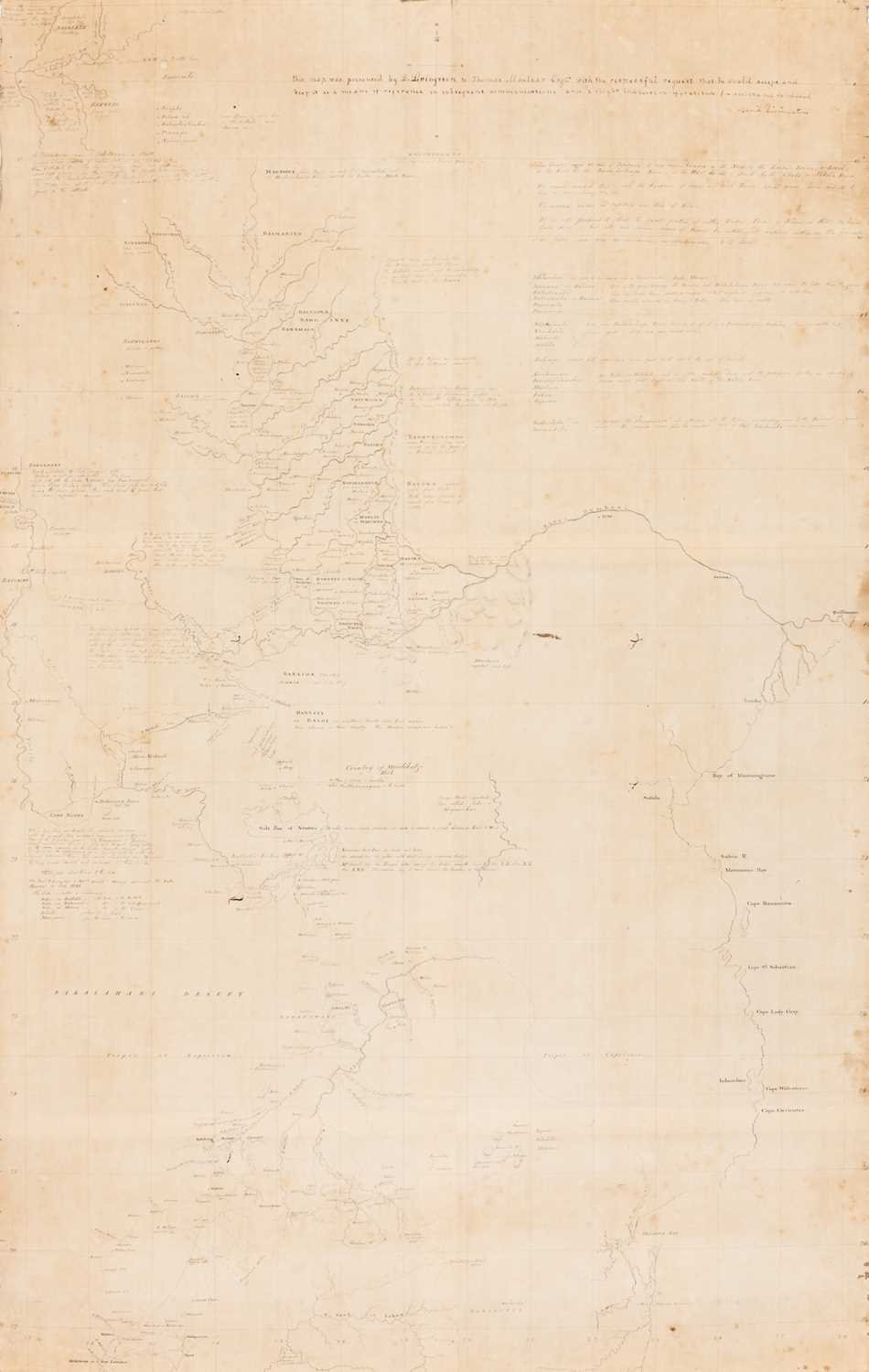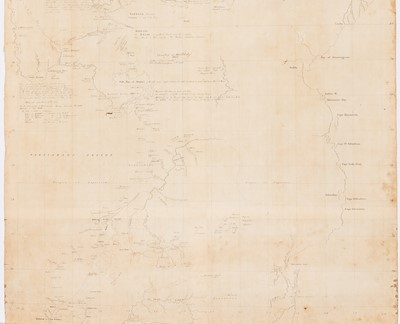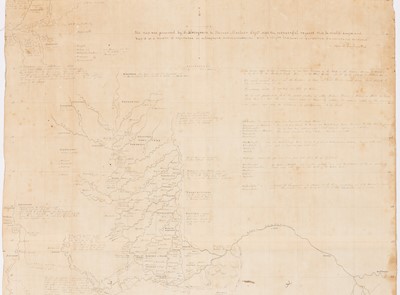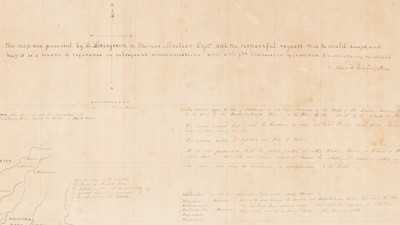Nov 7, 2023 10:00 EST
Rare Books, Autographs & Maps including the Esmond Bradley Martin Collection
178
A presentation map prepared by David Livingstone in Cape Town
Estate / Collection: The Esmond Bradley Martin Collection
LIVINGSTONE, DAVID
Manuscript map of Southern Africa. Cape Town: probably made under Livingstone's supervision in 1852 (inscribed at lower right "Copied by Thomas Budden May 1852"), inscribed with an autograph note signed by Livingstone presenting the map to his friend Thomas Maclear (the Astronomer Royal at Cape Town). Pen and ink on paper, laid-down to linen. 44 1/2 inches by 27 1/2 inches (113 x 70 cm); the features and notes are drawn and written in a single neat hand, the details extending from Latitude 28, (showing Kuruman in Bechuanaland in the south-west and Delagoa Bay in the south-east) northwards to Latitude 10 (showing the Balojazi country in the north-west, with the north-eastern area of the map blank as being unexplored), covered with notes referring to geographical features, the populations and physical conditions, and the extent of knowledge, ignorance and exploration of the area. Expected toning, a few peripheral small tears and chips. Note on verso in pencil "Map of Dr. Livingston's operations"
The autograph inscription signed by Livingstone is printed in a neat hand, likely Livingstone's own, reading: "This map was presented by D. Livingston to Thomas Maclear Esqre. with the respectful request that he would accept and keep it as a means of reference in subsequent communications and a slight indication of appreciation for assistance rendered to David Livingston." Livingstone arrived at Cape Town in April 1852, after eleven years' continuous work and exploration in Africa (1841-52), and remained until June, when he set out on the second of his series of journeys. It was at Cape Town between April and June 1852 that he met Thomas Maclear, Astronomer Royal at the Cape of Good Hope, and was instructed by him in taking sights and determining longitudes and latitudes. In view of Livingstone's inscription, it is very probable that the map was made in these months in 1852, and that the numerous notes on the area which the map contains embody Livingstone's own information. This dating is supported by the spelling "Livingston", which is the form used by the explorer until about 1857, when at his father's request he adopted the form "Livingstone", the original spelling of the family name. Livingstone was not in Cape Town again until 1858. We can be certain that the map is earlier than June 1860, when Maclear ("Esquire" in Livingstone's inscription) was knighted for his services. The latest date of information in the map is 1851, occurring in a note which begins "At the end of the remarkably dry season July 1851, the Beretse or Shishike River contained a volume of water from 300 to 500 yards wide and apparently deep..."
The information on the map extend to ethnographical details pertaining to the various tribes in the region, e.g. "Babimpe extract both upper and lower front teeth about the age of puberty"; physical features including rapids etc.; wildlife and potential foods such as dates and palmyra; climatological observations, etc. in short, Livingstone's observations would have provided a wealth of information for future travellers in the region, and it was presumably used by future expeditions.
Provenance: By descent from Sir Thomas Maclear to his daughter Mary, and thence by descent; sold Sotheby's Tuesday, 9th April, 1974, lot 656; to Maggs on behalf of Esmond Bradley Martin; thence by descent to the present owner.
Sold for $9,450
Estimated at $15,000 - $25,000
Includes Buyer's Premium
Estate / Collection: The Esmond Bradley Martin Collection
LIVINGSTONE, DAVID
Manuscript map of Southern Africa. Cape Town: probably made under Livingstone's supervision in 1852 (inscribed at lower right "Copied by Thomas Budden May 1852"), inscribed with an autograph note signed by Livingstone presenting the map to his friend Thomas Maclear (the Astronomer Royal at Cape Town). Pen and ink on paper, laid-down to linen. 44 1/2 inches by 27 1/2 inches (113 x 70 cm); the features and notes are drawn and written in a single neat hand, the details extending from Latitude 28, (showing Kuruman in Bechuanaland in the south-west and Delagoa Bay in the south-east) northwards to Latitude 10 (showing the Balojazi country in the north-west, with the north-eastern area of the map blank as being unexplored), covered with notes referring to geographical features, the populations and physical conditions, and the extent of knowledge, ignorance and exploration of the area. Expected toning, a few peripheral small tears and chips. Note on verso in pencil "Map of Dr. Livingston's operations"
The autograph inscription signed by Livingstone is printed in a neat hand, likely Livingstone's own, reading: "This map was presented by D. Livingston to Thomas Maclear Esqre. with the respectful request that he would accept and keep it as a means of reference in subsequent communications and a slight indication of appreciation for assistance rendered to David Livingston." Livingstone arrived at Cape Town in April 1852, after eleven years' continuous work and exploration in Africa (1841-52), and remained until June, when he set out on the second of his series of journeys. It was at Cape Town between April and June 1852 that he met Thomas Maclear, Astronomer Royal at the Cape of Good Hope, and was instructed by him in taking sights and determining longitudes and latitudes. In view of Livingstone's inscription, it is very probable that the map was made in these months in 1852, and that the numerous notes on the area which the map contains embody Livingstone's own information. This dating is supported by the spelling "Livingston", which is the form used by the explorer until about 1857, when at his father's request he adopted the form "Livingstone", the original spelling of the family name. Livingstone was not in Cape Town again until 1858. We can be certain that the map is earlier than June 1860, when Maclear ("Esquire" in Livingstone's inscription) was knighted for his services. The latest date of information in the map is 1851, occurring in a note which begins "At the end of the remarkably dry season July 1851, the Beretse or Shishike River contained a volume of water from 300 to 500 yards wide and apparently deep..."
The information on the map extend to ethnographical details pertaining to the various tribes in the region, e.g. "Babimpe extract both upper and lower front teeth about the age of puberty"; physical features including rapids etc.; wildlife and potential foods such as dates and palmyra; climatological observations, etc. in short, Livingstone's observations would have provided a wealth of information for future travellers in the region, and it was presumably used by future expeditions.
Provenance: By descent from Sir Thomas Maclear to his daughter Mary, and thence by descent; sold Sotheby's Tuesday, 9th April, 1974, lot 656; to Maggs on behalf of Esmond Bradley Martin; thence by descent to the present owner.
Auction: Rare Books, Autographs & Maps including the Esmond Bradley Martin Collection, Nov 7, 2023
-
Successful Auction of Rare Books, Autographs & Maps Tops $1 Million!
-
November 7, 2023 Sale Featured the Esmond Bradley Martin Collection of Africana & Travel
-
Consignments Are Currently Being Accepted for Future Auctions
NEW YORK, NY -- Doyle's successful auction of Rare Books, Autographs & Maps on November 7, 2023 topped $1 million amid competitive international bidding. Offerings in this popular sale spanned early illuminated manuscripts to modern literary first editions.
The Esmond Bradley Martin Collection of Africana and Travel comprised fascinating material that attracted bidders from around the world. Highlighting the collection was a copy of the first Latin edition of the earliest published collection of voyages, including those of Columbus and Vespucci: the 1508 Milan Fracanzo da Montalboddo, which achieved a strong $239,400. The collection also featured a rare uncut copy of Livio Sanuto's 1588 atlas of Africa that doubled its estimate at $25,200, as well as a group of 19th and early 20th century material relating to Zanzibar that attracted intense competition, sending the lots soaring over expectations. (Read more about Esmond Bradley Martin below.)
Property of other owners was highlighted by a first edition of Charles Darwin’s groundbreaking scientific work, On the Origin of Species, 1859, which realized $94,500. This copy bore provenance of Charles Darwin's great-grandson Quentin Keynes, to the naturalist Richard Bayard Dominick, thence by descent to the consignor.
Robert Browning's first edition copy of John Keats’ poem, Endymion, 1818, sold for $37,800, many times its $7,000-10,000 estimate. The poem begins with the well-known verse, "A thing of beauty is a joy for ever."
The selection of livres des artistes featured François-Louis Schmied's Daphne in a major Art Deco binding by Pierre Legrain, 1924, one of 140 copies. The book tripled its $8,000-12,000 estimate, selling for $32,760.
Manuscripts in the sale were highlighted by a medieval manuscript on paper, Calculus temporum Ecclesiasticus, which sailed past its estimate of $3,000-5,000 to achieve an exceptional $31,500. This fascinating calendrical manuscript in Latin, circa 1360, possibly English in origin, was once the property of antiquary and collector Sir Thomas Phillipps (1792-1872).
100 years before the Revolution: from Plymouth Colony to the Salem Witch Trials - The Victor Gulotta Collection, offered a curated collection of 17th and 18th century manuscripts documenting life in colonial New England. Among the rarities were a 1691 document signed by two notorious Salem witch trials magistrates John Hathorne and Jonathan Corwin that realized $5,670, a document from 1686/87 signed by Edmund Andros as Governor of the Dominion of New England that sold for $5,670, and a 1656 Boston court document relating to a divorce case that achieved $6,300, all three exceeding their estimates.
Esmond Bradley Martin
Esmond Bradley Martin (1941-2018) was educated as a geographer and philosopher. He and his wife Chryssee had an enduring fascination with Africa, and settled in Nairobi, Kenya, in the mid-1970s. He wrote extensively, oftentimes in conjunction with his wife, publishing works including Zanzibar. Tradition and Revolution, Hamish Hamilton, 1978; Cargoes of the east. The ports, trade, and culture of the Arabian Seas and western Indian Ocean, Elm Tree Press, 1978; and many other works on African history and conservation. In the late 1970s, he began extensive research into the illegal trade in elephant ivory and rhino horn, which included substantial stints incognito posing as a buyer of illicit wildlife products. For a while, he served as special envoy for rhino conservation for the United Nations. He continued this work until 2018 , when tragically he was stabbed to death in his Nairobi home
For about thirty years, beginning in the mid-1960s, Esmond Bradley Martin assiduously collected books and manuscripts on Africa and its history, acquiring a phenomenal collection of letters by many of the major English explorers of the nineteenth century, as well as numerous rarities from earlier centuries. He was buying at a time when troves of such material surfaced frequently at English auctions. Doyle was privileged to offer the first selection of his collection in the November 7 auction. A second and final portion will be offered early next year.
We Invite You to Auction!
Consignments are currently being accepted for future auctions. We invite you to contact us for a complimentary auction evaluation. Our Specialists are always available to discuss the sale of a single item or an entire collection.
For information, please contact Peter Costanzo at 212-427-4141, ext 248, or Edward Ripley-Duggan at ext. 234, or email Books@Doyle.com




